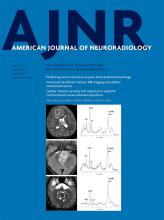Index by author
Serena, J.
- EDITOR'S CHOICEAdult BrainOpen AccessPredicting Motor Outcome in Acute Intracerebral HemorrhageJ. Puig, G. Blasco, M. Terceño, P. Daunis-i-Estadella, G. Schlaug, M. Hernandez-Perez, V. Cuba, G. Carbó, J. Serena, M. Essig, C.R. Figley, K. Nael, C. Leiva-Salinas, S. Pedraza and Y. SilvaAmerican Journal of Neuroradiology May 2019, 40 (5) 769-775; DOI: https://doi.org/10.3174/ajnr.A6038
The authors prospectively studied patients with motor deficits secondary to primary intracerebral hemorrhage within the first 12 hours of symptom onset. Patients underwent multimodal MR imaging including DTI. Intracerebral hemorrhage, perihematomal edema location and volume, and corticospinal tract involvement were assessed. The corticospinal tract was considered affected when the tractogram passed through the intracerebral hemorrhage and/or the perihematomal edema. The authors calculated affected corticospinal tract-to-unaffected corticospinal tract ratios for fractional anisotropy, mean diffusivity, and axial and radial diffusivities. Significant independent predictors of motor outcome were NIHSS and modified NIHSS at admission, posterior limb of the internal capsule involvement by intracerebral hemorrhage at admission, intracerebral hemorrhage volume at admission, 72-hour NIHSS, and 72-hour modified NIHSS. The sensitivity, specificity, and positive and negative predictive values for poor motor outcome at 3 months by a combined modified NIHSS of >6 and posterior limb of the internal capsule involvement in the first 12 hours from symptom onset were 84%, 79%, 65%, and 92%, respectively.
Shah, N.J.
- Adult BrainYou have accessIncreased Water Content in Periventricular Caps in Patients without Acute HydrocephalusT. Sichtermann, J.K. Furtmann, S. Dekeyzer, G. Gilmour, A.M. Oros-Peusquens, J.P. Bach, M. Wiesmann, N.J. Shah and O. NikoubashmanAmerican Journal of Neuroradiology May 2019, 40 (5) 784-787; DOI: https://doi.org/10.3174/ajnr.A6033
Shah, V.N.
- Head & NeckOpen AccessReduced Jet Velocity in Venous Flow after CSF Drainage: Assessing Hemodynamic Causes of Pulsatile TinnitusH. Haraldsson, J.R. Leach, E.I. Kao, A.G. Wright, S.G. Ammanuel, R.S. Khangura, M.K. Ballweber, C.T. Chin, V.N. Shah, K. Meisel, D.A. Saloner and M.R. AmansAmerican Journal of Neuroradiology May 2019, 40 (5) 849-854; DOI: https://doi.org/10.3174/ajnr.A6043
Sharma, A.
- Adult BrainYou have accessImage Processing to Improve Detection of Mesial Temporal Sclerosis in AdultsF. Dahi, M.S. Parsons, H.L.P. Orlowski, A. Salter, S. Dahiya and A. SharmaAmerican Journal of Neuroradiology May 2019, 40 (5) 798-801; DOI: https://doi.org/10.3174/ajnr.A6022
Shimogonya, Y.
- NeurointerventionOpen AccessDifferences in Cerebral Aneurysm Rupture Rate According to Arterial Anatomies Depend on the Hemodynamic EnvironmentS. Fukuda, Y. Shimogonya and N. Yonemoto on behalf of the CFD ABO Study GroupAmerican Journal of Neuroradiology May 2019, 40 (5) 834-839; DOI: https://doi.org/10.3174/ajnr.A6030
Shin, N.Y.
- NeurointerventionYou have accessImage Quality of Low-Dose Cerebral Angiography and Effectiveness of Clinical Implementation on Diagnostic and Neurointerventional Procedures for Intracranial AneurysmsJ. Choi, B. Kim, Y. Choi, N.Y. Shin, J. Jang, H.S. Choi, S.L. Jung and K.J. AhnAmerican Journal of Neuroradiology May 2019, 40 (5) 827-833; DOI: https://doi.org/10.3174/ajnr.A6029
Sichtermann, T.
- Adult BrainYou have accessIncreased Water Content in Periventricular Caps in Patients without Acute HydrocephalusT. Sichtermann, J.K. Furtmann, S. Dekeyzer, G. Gilmour, A.M. Oros-Peusquens, J.P. Bach, M. Wiesmann, N.J. Shah and O. NikoubashmanAmerican Journal of Neuroradiology May 2019, 40 (5) 784-787; DOI: https://doi.org/10.3174/ajnr.A6033
Silva, Y.
- EDITOR'S CHOICEAdult BrainOpen AccessPredicting Motor Outcome in Acute Intracerebral HemorrhageJ. Puig, G. Blasco, M. Terceño, P. Daunis-i-Estadella, G. Schlaug, M. Hernandez-Perez, V. Cuba, G. Carbó, J. Serena, M. Essig, C.R. Figley, K. Nael, C. Leiva-Salinas, S. Pedraza and Y. SilvaAmerican Journal of Neuroradiology May 2019, 40 (5) 769-775; DOI: https://doi.org/10.3174/ajnr.A6038
The authors prospectively studied patients with motor deficits secondary to primary intracerebral hemorrhage within the first 12 hours of symptom onset. Patients underwent multimodal MR imaging including DTI. Intracerebral hemorrhage, perihematomal edema location and volume, and corticospinal tract involvement were assessed. The corticospinal tract was considered affected when the tractogram passed through the intracerebral hemorrhage and/or the perihematomal edema. The authors calculated affected corticospinal tract-to-unaffected corticospinal tract ratios for fractional anisotropy, mean diffusivity, and axial and radial diffusivities. Significant independent predictors of motor outcome were NIHSS and modified NIHSS at admission, posterior limb of the internal capsule involvement by intracerebral hemorrhage at admission, intracerebral hemorrhage volume at admission, 72-hour NIHSS, and 72-hour modified NIHSS. The sensitivity, specificity, and positive and negative predictive values for poor motor outcome at 3 months by a combined modified NIHSS of >6 and posterior limb of the internal capsule involvement in the first 12 hours from symptom onset were 84%, 79%, 65%, and 92%, respectively.
Southard, R.N.
- PediatricsYou have accessComparison of Iterative Model Reconstruction versus Filtered Back-Projection in Pediatric Emergency Head CT: Dose, Image Quality, and Image-Reconstruction TimesR.N. Southard, D.M.E. Bardo, M.H. Temkit, M.A. Thorkelson, R.A. Augustyn and C.A. MartinotAmerican Journal of Neuroradiology May 2019, 40 (5) 866-871; DOI: https://doi.org/10.3174/ajnr.A6034
Standaert, C.J.
- EDITOR'S CHOICESpineOpen AccessLumbar Spinal Stenosis Severity by CT or MRI Does Not Predict Response to Epidural Corticosteroid versus Lidocaine InjectionsF.A. Perez, S. Quinet, J.G. Jarvik, Q.T. Nguyen, E. Aghayev, D. Jitjai, W.D. Hwang, E.R. Jarvik, S.S. Nedeljkovic, A.L. Avins, J.M. Schwalb, F.E. Diehn, C.J. Standaert, D.R. Nerenz, T. Annaswamy, Z. Bauer, D. Haynor, P.J. Heagerty and J.L. FriedlyAmerican Journal of Neuroradiology May 2019, 40 (5) 908-915; DOI: https://doi.org/10.3174/ajnr.A6050
In this secondary analysis of the CT and MR imaging studies of the prospective, double-blind Lumbar Epidural Steroid Injections for Spinal Stenosis (LESS) trial participants, the authors found no differences in baseline imaging characteristics between those receiving epidural corticosteroid and lidocaine and those receiving lidocaine alone injections. No imaging measures of spinal stenosis were associated with a differential response to corticosteroids, indicating that imaging parameters of spinal stenosis did not predict a response to epidural corticosteroids.








